A Day in the Life of a Medieval Times’ Knight
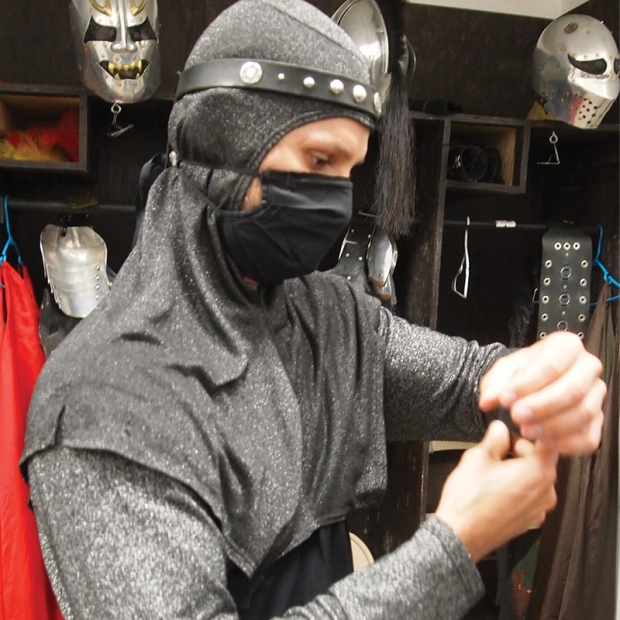
In our ongoing series, A Day in the Life, together we’ve explored a few of the many fascinating jobs required to keep a place as diverse as the Grand Strand fun, safe and fulfilling for locals and visitors. We’ve covered a lot of ground, including in-depth profiles of an area K-9 officer, mayor, judge, shrimp boat captain, culinary arts educator and many others. In this issue, we’ll ask you to suspend your disbelief and travel back in time to feudal Spain where a knight’s valor, horsemanship, expertise in war and political savvy were often his only salvation. Thus is the general theme of the popular dinner theater attraction Medieval Times, where cheering on your very own knight comes with a queen and her evil advisor, a four-course meal delivered by serving wenches and a side of fun.
I was recently given an inside look at just what’s required of a young man (no women allowed in this role) as he moves from squire to knight in a daily show, how he becomes an expert horseman and how the fantasy comes to life for the audience amid the thrill of pounding hooves, medieval war games, falconry, and a half a rotisserie chicken, plus sides, a drink and dessert.
With nine castles located in the U.S. and one in Canada, this Spanish family-founded dinner theater concept has been entertaining and feeding guests since 1983, beginning with its very first castle in Orlando, Florida. Closer to home, Fantasy Harbour (Highway 501 at the Intracoastal Waterway) in Myrtle Beach has seen a string of theater and theme parks start and stop over the past nearly 30 years, while Medieval Times has remained open and strong for 26 seasons. But how does a show of this magnitude come across so flawlessly with each performance? How does a busboy from Myrtle Beach become a squire, and then become a knight? It starts with training and ends with experience.
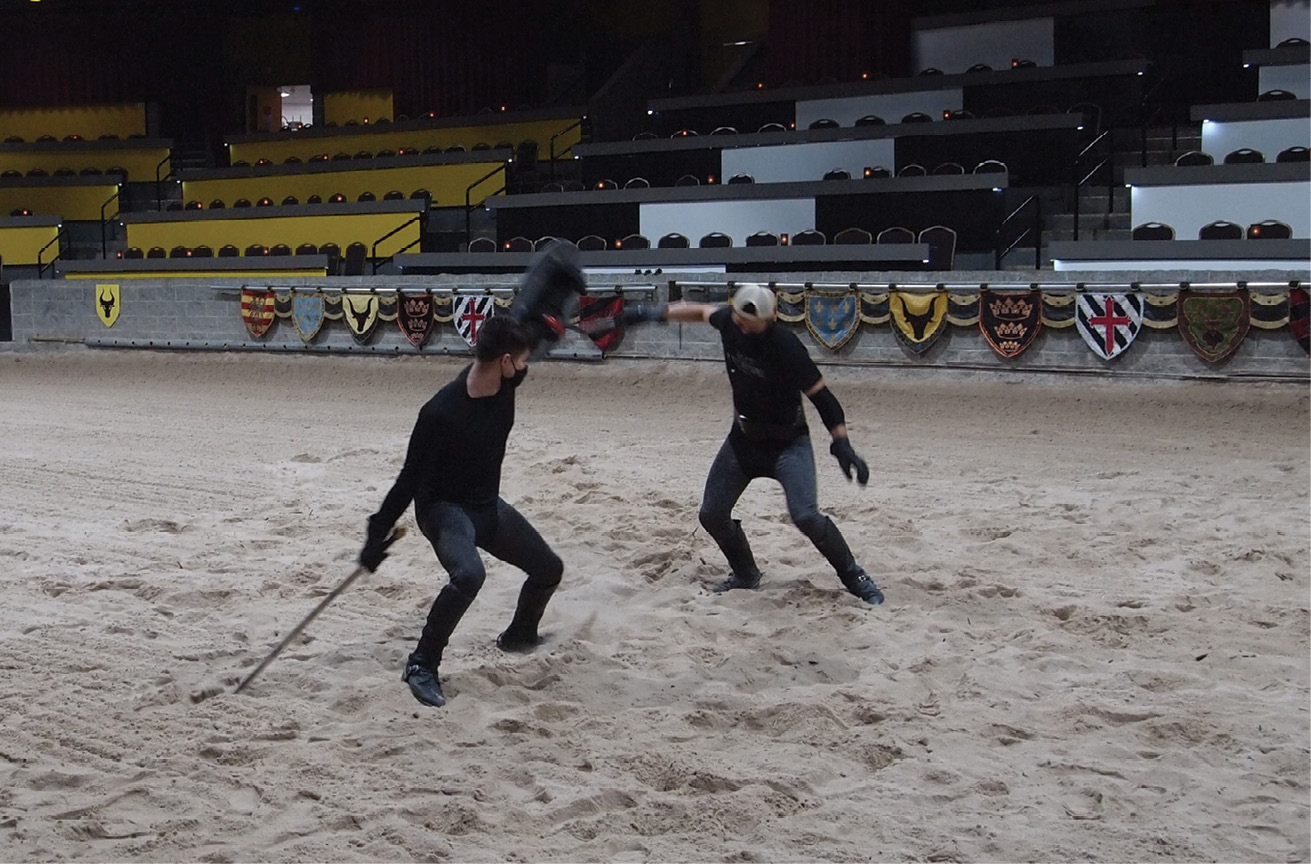
11:45 a.m.
Long before the castle/arena opens to the public, knights and squires show up for the combat training and horse skills that are a part of every workday. “We do the moves over and over again,” says 32-year-old knight Zach Walker, a lifetime Myrtle Beach resident and noble knight for the past six years.
Walker is tall, athletic, has a wide, boyish smile and only recently cut his knightly mane that used to reach the middle of his back. We meet in the knights’ and squires’ locker room, where a dozen men ranging from 19 to 49 years old layer up in various spandex riding tights, workout clothing and polycarbonate modified motocross protective chest and back plates, all in preparation for the afternoon’s fight training.
Corporate show manager Jim Collins, 49, has been with the company for 25 years and has called Myrtle Beach home for more than 30. Though he travels to all of the 10 properties and floats around to manage choreography, story changes and training—along with sound, lights, stables and as a troubleshooter—the Myrtle Beach castle is “home.” “I was a knight for many years,” says Collins. He, too, is tall and athletic and fits the knightly profile. “I’m still a knight and perform occasionally. I started out like everyone; a squire, then became a knight, then head knight, and eventually show manager here, and finally corporate show manager.”
All knights start with the not-always-so-enviable duty of squire, where, in addition to being an official pooper-scooper in the arena, they assist their knights by making sure they have everything needed for a thrilling performance. Horsemanship and fight training also begin on day one.
12:15 p.m.
We move to the large arena with its sandy footing, perfectly suited to galloping horses and the pratfalls of knights. The 1,200 empty seats will soon have a reduced crowd, around 600, socially distanced for the show later that day. One-on-one combat training commences with head knight Victor Velasquez running the trainees through combat and weapons training; even veteran knights train every day. In the same way professional wrestlers and Hollywood stuntmen choreograph mock fights, the knights here must be well trained to avoid serious injury. The swords, lances, mace, bola and alabarda are all solid metal and wood, heavy and life threatening to both the trained and untrained. They take safety very seriously, but rare accidents do happen.
“I’ve been hit in the back of the head and had my bell rung more than once,” says Walker. “We all have.” When in the course of battle the two combatants clash, literal sparks fly and the noise of a large sword or battle-axe hitting a metal shield can be quite dramatic. Hidden shotgun microphones in the ceiling, pointing downward, further amplify and enhance the sound. The choreography and show are the same at each of the 10 theaters, so that any knight from Myrtle Beach should be able to drop into the castle in Canada, for example, and step into the role without issue. The content of the shows changes each six to seven years and was most recently changed a couple of years ago. For the first time ever, a queen now rules the realm instead of a king. The company does hire many women in a variety of roles, in the show and behind the scenes, just not as knights. Those positions are cast from the traditional male dominated knighthood known from antiquity.
1:15 p.m.
The knights in training spend part of each workday in combat training and horsemanship, as it’s the only way up the ladder. “Most people have little or no horse training when they start work here,” says Walker, “so it’s important that they first learn horse etiquette; how to walk the horses, ride them correctly, brush them, how to have a relationship with them and all that.” Most new hires remain squires for around a year, while others’ training takes longer. Squires also assist the knights before, during and after the show. Walker had never even seen the show when he was first hired, but was ready to leave a job at Belk in the makeup department to pursue what seemed like an adventure.
“I stayed a squire for around seven or eight months,” he says, and recounts the story of seeing a knight’s accoutrements at a museum while visiting Russia with his then new wife, Russian-born Anastasia. “I thought how cool would it have been to be a knight, and then really didn’t give it another thought.”
It wasn’t until he was back in Myrtle Beach shortly after returning that he was recruited at a local restaurant from the Medieval Times head knight, since retired. “He offered me the job,” adds Walker. “I was making good money at the time between Belk and bussing tables at Margaritaville—but it seemed like a great opportunity, so I said yes. And here I am.”
1:55 p.m.
Jousting practice requires a bit more set up, starting with moving the horses from their stables to the arena. Though the Medieval Times’ knights get a lot of attention, everyone knows who the real stars are: the horses.
The corporation, still owned in part by the Spanish family who created the show, along with a conglomerate of investors, breed horses at their ranch in Texas and utilize Quarter Horses and Friesians, but the Andalusian breed is spectacular. Each has a lineage and pedigree dating back many, many generations to Spain, where the story of Medieval Times began.
In full armor and protective gear, the knights and squires practice falling, which is most of what makes jousting so fun to watch. While the horse is moving at what must be close to full speed, the rider must carefully catapult himself from the saddle after being hit by the lance to roll in the sand. It has to look real, and to look real without injuring oneself requires practice, and then some more practice, and then some more.
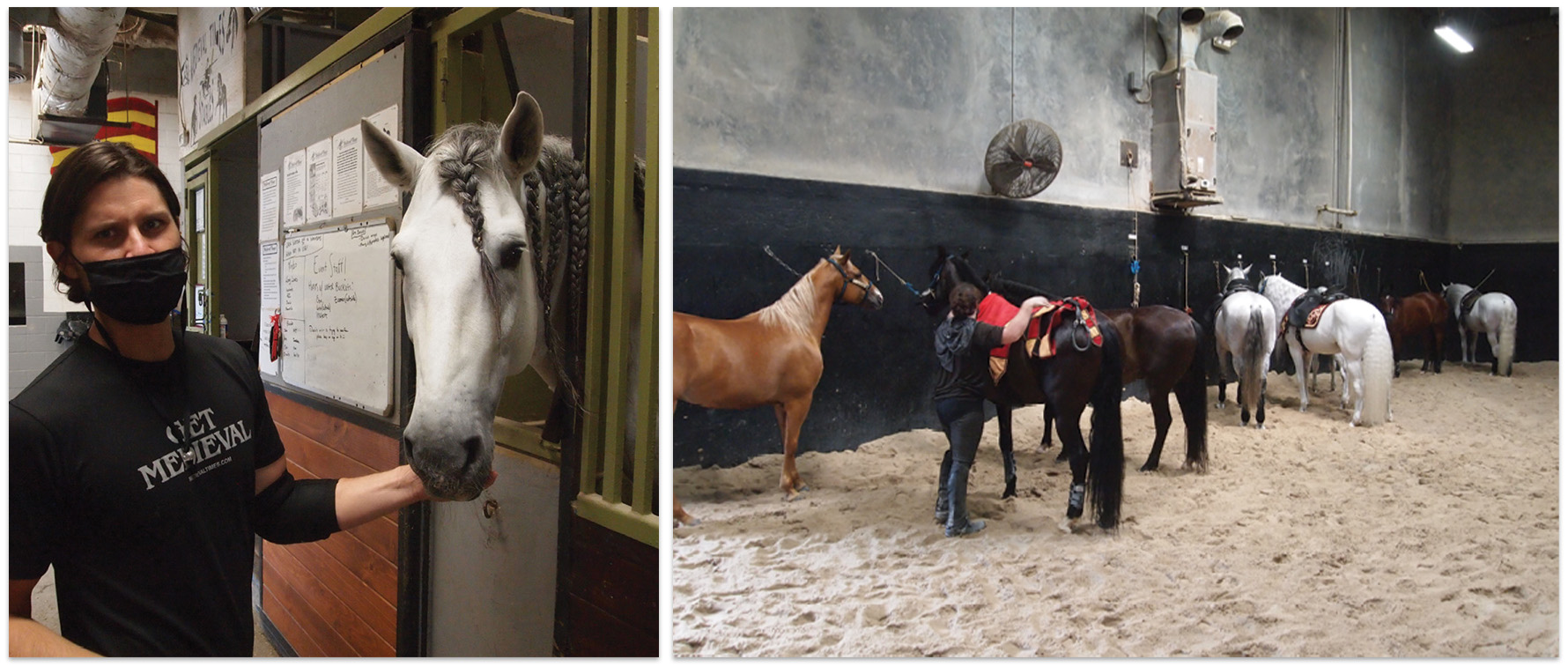
2:15 p.m.
Walker takes me to the stable and introduces me to each of the 23 horses currently in Myrtle Beach, young and middle-aged, each curious, calm and with their own personality and their own specialty. Some, like 6-year-old Lirico, is specially trained to allow the knights to fall off him. Each horse is treated with kindness and respect and live out their eventual retirement at the corporate Texas ranch with plenty of good food, other horses and excellent veterinary care.
“We like to train the horses to each do a special part of the show,” says Walker, “and we don’t use all of the horses in each show—we give them a break and rotate them around.” I comment that each of the knights, Walker included, look younger than their average age of 30-something. “That’s because falling off a horse and the fighting gives you a quick shot of adrenaline, releases HGH, the longevity and youth hormone,” says Walker, suddenly dispensing convincing naturopathic advice. “It makes your muscles more taut, your bones denser, your skin looks better. It’s the natural and holistic way to look and feel younger.”
I don’t argue with him, as the 32-year-old does look like a teenager, but I can honestly say it’s the first time I’ve heard that falling off horses and fighting in a suit of armor was good for you.
2:40 p.m.
In the back halls and bowels of the building, parts of the castle few ever see, I pass by a kitchen already in preparation for some 500-meals (and capable of delivering 1,200 simultaneously). I see the wardrobe department where capes, robes and the colorful garments used in the pageantry are mended and washed and altered to fit each new cast member. I visit the stables where full-time horse trainers tend to the show’s stars. I am so worn out from watching other people work so hard, I agree to take a break and come back before showtime, 5 p.m.
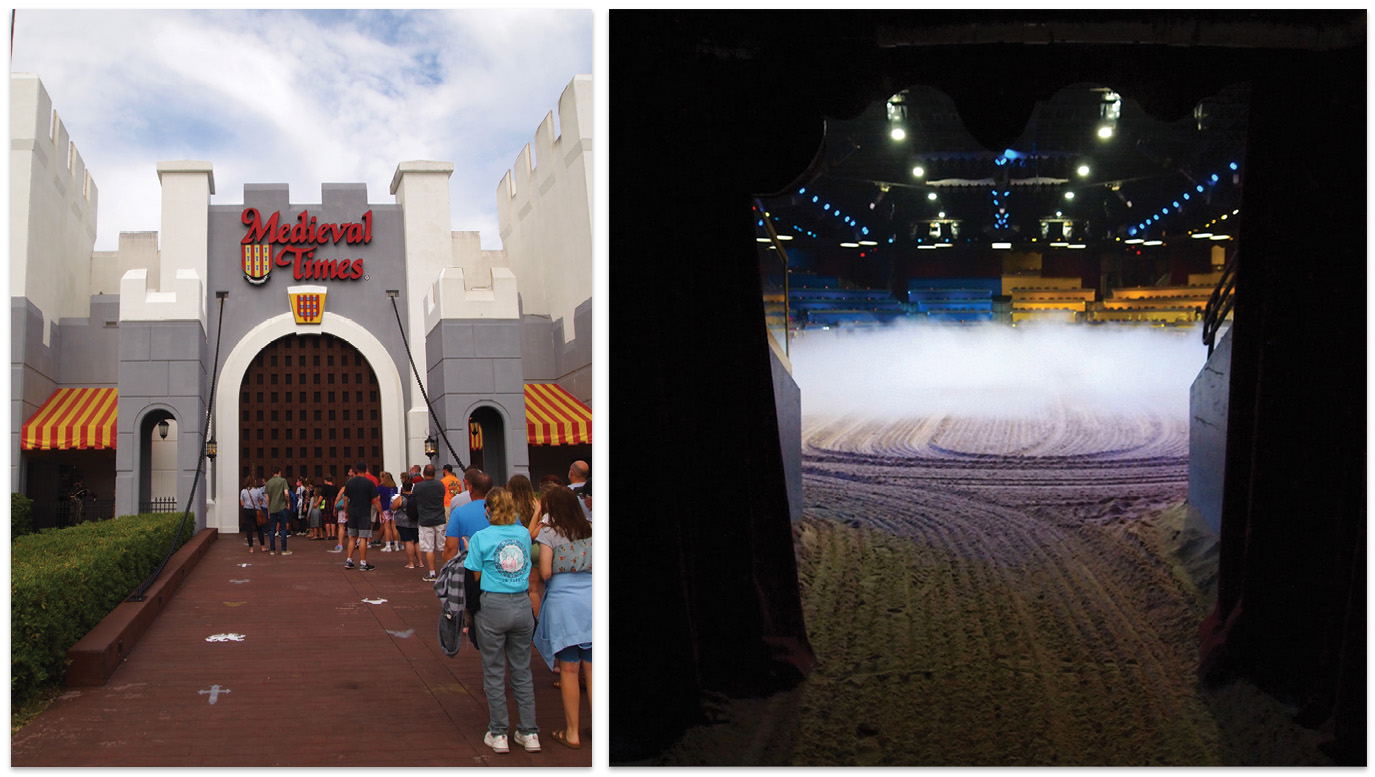
4:20 p.m.
A line of visitors, already assembled just outside the gate, waits their turn to be let in the main castle doors. Young and old, and lots and lots of children pour through the doors after a few announcements are made, all with the same regal pomp and ceremony as incorporated in the rest of the Medieval Times experience.
4:30 p.m.
In the main hall, guests, who’ve each paid around $56 per ticket ($29 for children) meander among dazzling displays of weaponry, coats of arms, merchandise and memorabilia. Most of the kids are insistent on obtaining multi-colored flashing swords and other props. A few guests of drinking age saunter to the bar, getting a head start on the festivities, all while waiting for seat assignments and instructions from the larger-than-life Royal Emcee, Corwin Hacha, who, from what I could tell, is never out of character. Ever. Each family or group is assigned a color, which will correspond with a particular knight. Walker will be the Blue Knight, and so I’m given a blue ticket and ushered into the arena.

4:50 p.m.
The arena looks very different at showtime, as the fantasy begins to take form. Darkened, but with special effects lighting and manmade fog settling over the sand, we spectators take our seats. Because of pandemic restrictions, we’re socially distanced, and our serving wenches wear non-period plastic face guards. My seat secure, I rush backstage just before showtime to catch up with Walker, who also looks different now that he’s layered in all the wardrobe for the opening ceremony. He takes me to his horse, where he goes through something akin to a preflight inspection.
“I check all the [tack] and make sure everything’s positioned just right,” he says, tightening the leather straps around each of the horse’s feet, checking the bit and tending to the horse’s needs. There’s excitement building and a little tension backstage as the clock ticks closer to the downbeat.

5:00 p.m.
The music swells, and it’s a fantastic, original, movie-worthy score that plays uninterrupted for nearly two hours. One after another, the horses and their knights thunder into the arena to the delight of the crowd. We’re introduced to each knight, who remains positioned adjacent to his corresponding color, while the serving wenches start their rounds.
General Manager Chris Irizarry, with the company for 16 years and the GM of the Myrtle Beach location for three, tells me the crowds have been great and nearly at capacity, which is still only 50 percent during pandemic restrictions.
“Even the off-season has been as good or better than we expected,” he says. He helps a confused family find their seats, as the entry process has been retooled to meet social distancing protocol. Each guest has had his or her temperature taken at the entrance with an automatic device that only requires you to look at it for less than two seconds. All part of the new normal.
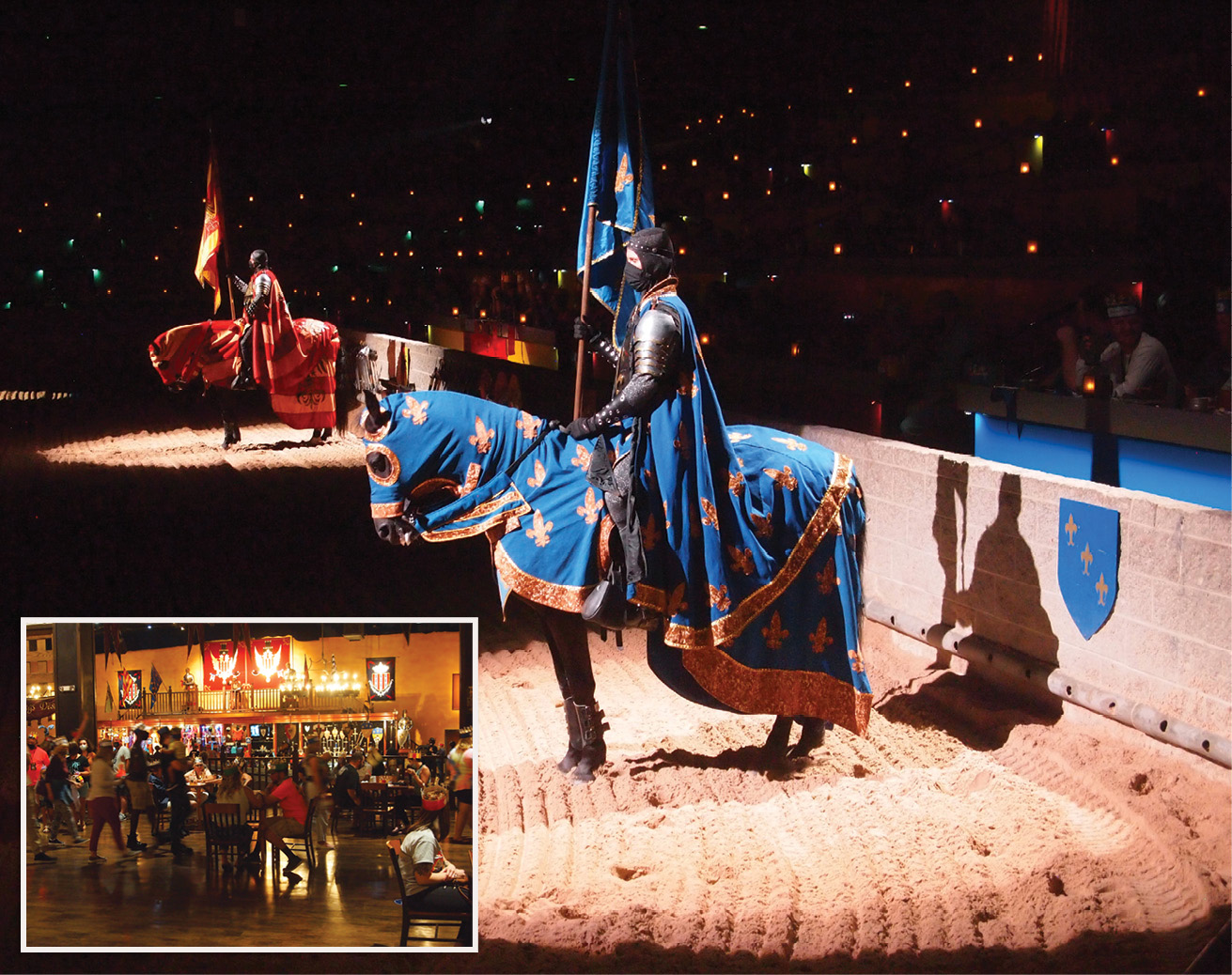
5:15 p.m.
In the arena, the Emcee and Queen, played by Natalie Bennett, have been debating and maneuvering; high stakes political intrigue seem to be taking over the kingdom. Walker already knows whether he wins or loses various jousts. A show board back stage lets each knight know the score before the first battle begins.
5:30 p.m.
The hot food comes in waves; first a piece of toasty garlic bread, then soup served in a crock with a handle, then a half-rotisserie chicken with a couple of sides. No utensils. Rip your food apart and feed your face medieval style. I did see a few patrons who must have coerced plastic silverware from their wench, but I was okay going old-school. In the arena, Walker regularly visits our blue section and waves to the crowd, making eye contact with the kids and the ladies, and we cheer him on at every turn.
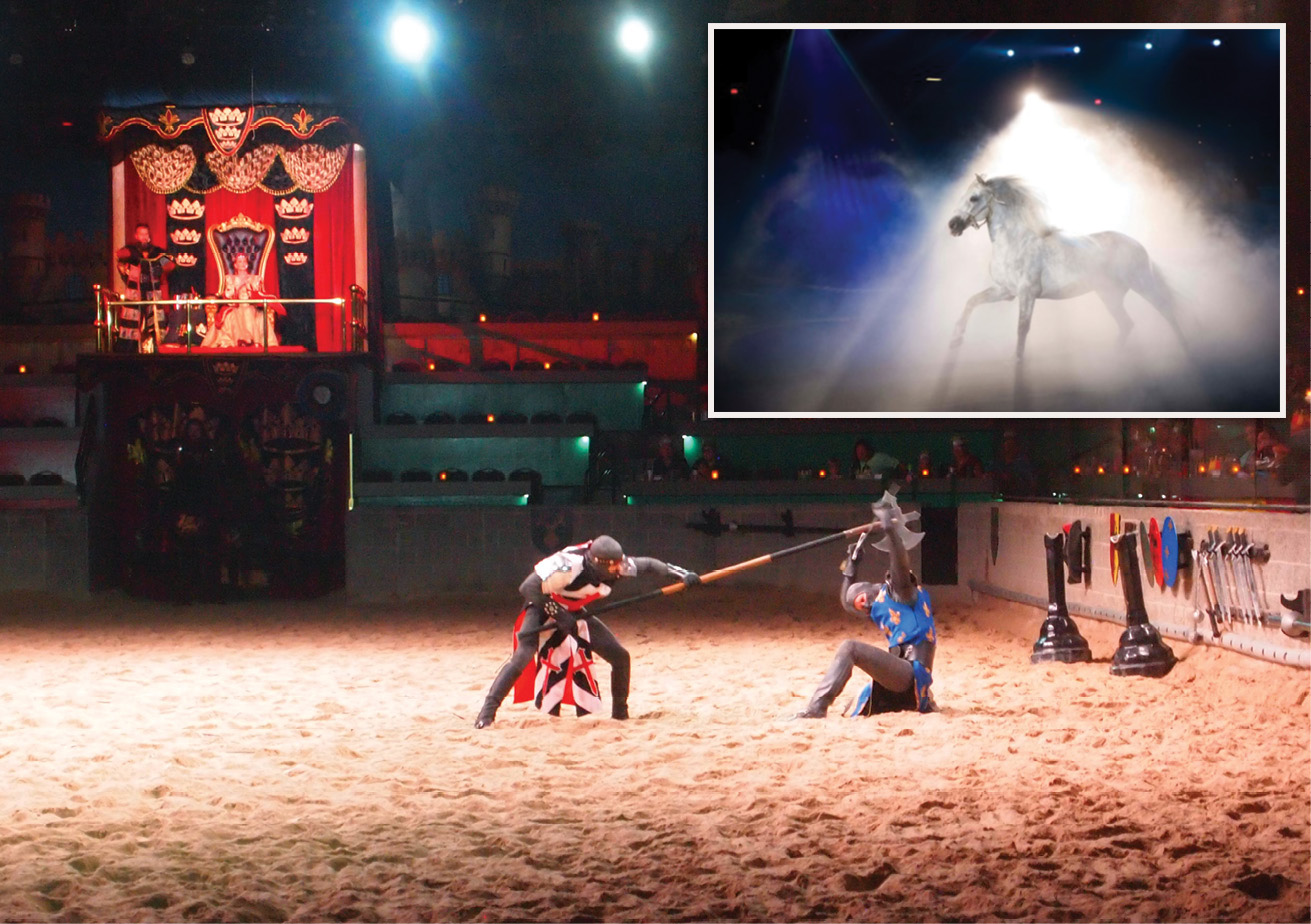
6:00 p.m.
The highlight of the show, for many, besides the jousting, are when the falconer comes to the center of the arena and launches the Lanner flacon high into the air. The bird swoops just over our heads in figure eight patterns that cover every inch of the arena. But when Jefe, the 7-year old snow white Andalusian comes center stage, he commands complete attention. The horse and trainer go through a series of maneuvers that are magnificent to behold. Medieval Times is unmistakably a horse show, first and foremost.
6:55 p.m.
With the games, dinner and the royal politics wrapping up, and after a little ice cream (I did get a spoon for that), I head backstage to check in with Walker. He is drenched in sweat and seems happy to have played his part in the nightly drama.
“Yeah, we do this five or six times each week,” he says, stripping off layer after layer, like a medieval onion. “It’s a great job and a great company to work for. Look how long most of the people have been here.”
It’s also hard work, but rewarding in surprising ways—apparently, knighthood keeps you young. Who knew?
For ticket information, visit medievaltimes.com